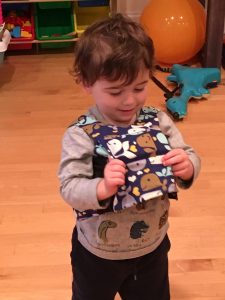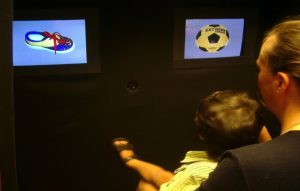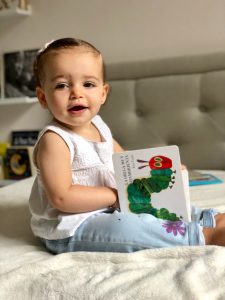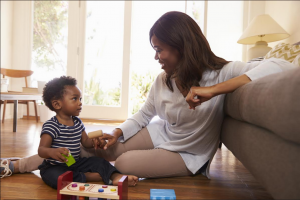Bi-TODLS: Bilingual Toddlers’ Development of Language Skills Characterizing young children’s language development trajectories is critical to be able to identify and provide services to those who may have difficulties learning language. Although there is research on the language trajectories of monolingual children, bilingual children have been understudied. This longitudinal project investigates how familiar word recognition and learning new words relate to future vocabulary outcomes for English-Spanish bilingual toddlers. Our goal is to investigate what aspects of language best predict trajectories of vocabulary growth for bilingual children in order to improve early identification of bilingual children with language impairments.
 Exploring the early language environments of babies and toddlers
Exploring the early language environments of babies and toddlers

How do children learn to understand and speak English and Spanish?
Many children around the world grow up learning two languages. How do they do this? In this project, children watch pairs of images as they listen to speech in English and Spanish, and we monitor their eye movements to see how quickly they make sense of spoken language. We are following children over time to ask: How does their processing of Spanish and English change during the preschool years? Does experience with one language help them understand a second one? How do language interactions in and outside the home support bilingual development?
LEAP: Literacy Empowerment Access Partnership
The Literacy Empowerment Access Partnership (LEAP) is a partnership between the Northwestern University (NU) Settlement House, Early Childhood Education (a preschool serving families from diverse backgrounds), and the Child Language Lab from NU, funded by the NU Racial Equity and Community Partnership program. This is a collaborative project between teachers, principals, researchers, and parents. LEAP’s primary goal is to promote equity in early literacy by: 1) creating the “I Can See Myself” library, a preschool lending library that has been restocked with culturally and linguistically affirming books so that children and caregivers feel represented in the books they read; 2) developing a Parent Fellowship Program where caregivers share what literacy means to them, identify the literacy practices that they already do at home, and address any questions or concerns on early literacy and bilingualism. Through these two components, the goal is to bridge early literacy practices between home and school for Black and Latinx children and families.

Leyendo Juntos: Promoting early literacy in pediatric primary care
In this project, we are exploring how promoting early literacy activities affects early language interactions in Latino families. Leyendo Juntos is a cultural and linguistic adaptation of a program in which pediatricians give families children’s books and guidance about reading aloud. This study will assess whether Leyendo Juntos: 1) increases pediatric providers’ knowledge and implementation of culturally responsive practice in literacy promotion with Latino families, and 2) enhances parent-child language and reading interactions and child vocabulary development in Latino families with young children.
LIBRO: Language Interactions in Book-reading Observations
In this project, we are interested in caregiver-child language interactions during bookreading in bilingual Latinx families. More specifically, we are investigating how caregiver-child language interactions during bookreading might differ: 1) when using bilingual vs monolingual books, and 2) when using books with and without culturally relevant themes and characters. To investigate this, preschool aged children (3-5 years old) engage with their caregivers in a virtual bookreading activity via Zoom using a set of books that we provide. We hope this study will provide useful information for families, practitioners, and policymakers about how different kinds of books support early literacy in Latinx children.
SPAH Kids: Stress, Pregnancy, and Health
The SPAH Kids study examines the effect of maternal stress during pregnancy on a child’s development. This study looks at societal causes of stress, such as the Covid-19 pandemic and discrimination, as well as other daily life stress. SPAH Kids hopes to better understand how these stressors impact a child’s learning environment at home and their development from 1 to 5 years. SPAH stands for Stress, Pregnancy, and Health.
TODLS: Story Slam
Children love telling stories. Developmentally, children move from using single words and short sentences to describe simple events, to using multiple sentences to describe a series of events – a narrative. We can learn a lot about a child’s language skills by studying how they tell stories. In this study, we investigate a component of storytelling that is often overlooked: how children use their hands – gestures – when producing a narrative. Testing the idea that children with spoken language difficulties use more gestures to assist with communication, we ask whether children’s gesture use during storytelling is linked to their verbal language ability. Understanding how children use gestures in storytelling may help us better support those who have difficulty with learning language.
 TODLS: Toddlers’ Development of Language Skills
TODLS: Toddlers’ Development of Language Skills
Learning new words is a complicated process! Every word that we know has both a meaning — the object or idea the word represents — and a form — the specific sounds that make up that word. Children need to learn both of these things at the same time in order to understand new words that they hear grownups using around them. In this project, we are interested in how different children understand both the meaning and the sounds of the words they learn. By understanding how children balance these two parts of learning words, we may be better able to help children who have difficulty with learning language.
